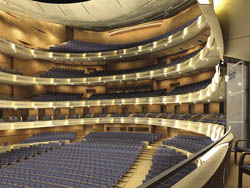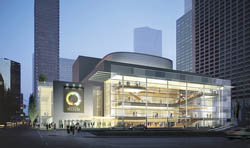- TORONTO, CANADA-The Canadian Opera Company (COC) has been in existence for more than half a century, but it's finally coming home. In a much-anticipated debut, Toronto's Four Seasons Centre for the Performing Arts assumes its rightful place on the global map of great opera houses with a series of inaugural events this summer, followed by the launching of the 2006/2007 opera season with the presentation of Wagner's Ring Cycle.
Four Seasons Centre for the Performing Arts' understated, black-iron-spot, brick structure in the heart of Toronto entices with its glass City Room entrance.
The understated, black-iron-spot, brick structure in the heart of Toronto entices with its glass City Room entrance and public/social space, a sparkling prelude to the 2,000-seat curvilinear R. Fraser Elliot Hall, a 5-tiered, horseshow-shaped auditorium conceived for acoustics, opera, and ballet sightlines, and an easy intimacy. A textured plaster shell offers sound reflection, diffusion, and human scale to the hall, and a series of layered plaster ceiling "clouds" reinforce sound density while the spaces between layers conceal stage positions such as a follow-spot booth.
Designed by the Toronto firm, Diamond and Schmitt Architects, the Centre features theater design/planning by Fisher Dachs Associates (NY) and the services of lead acoustician, Robert Essert, Sound Space Design (London, U.K). Consultants include Wilson, Ihrig & Associates (Oakland CA), Aercoustics Engineering (Toronto), and Engineering Harmonics (Toronto). The AV system was installed by MacLean Media Systems (Burlington, Ontario).

The 2,000-seat curvilinear R. Fraser Elliot Hall features BSS BLU-80 and BLU-32 signal processing, a Yamaha DM-2000v2 console, and 112
The hall redresses many of the technical shortcomings of old-world theaters while retaining their noted warmth, Lella added. "We worked very hard to make the room look and feel effortless. Don't be fooled by the minimal architectural expression. The state-of-the-art systems-a huge mechanical and electrical infrastructure threaded through complicated structural gymnastics-are carefully hidden throughout."
Engineering Harmonics was recruited to design the Centre's $1.3 million (Canadian) AV system by Essert, with whom they are collaborating on other projects, including Toronto's Royal Conservatory of Music Recital Hall, opening in 2008. The Four Seasons Centre's system features BSS BLU-80 and BLU-32 signal processing, a Yamaha DM-2000v2 console, and 112 Meyer MM-4s with a full complement of other Meyer gear, including the CQ-1 and CQ-2, 14 UPJ-1Ps, 6 UPM-1Ps, and 4 PSW2s. Mics include a variety of Sennheiser models.
"We approached the sound system as part of a team," revealed EH president/owner, Phil Giddings. "In turn, we brought in Roger Gans, sound designer for the San Francisco Opera. San Francisco is probably the leading opera company in North America with regard to the use of sound technology and sound design, and one of the goals of the COC is to be at the forefront in its use of sound equipment installed and used in a discreet way."
Essentially, there were two primary performance sound requirements for the Centre, Giddings said. "The opera company will use the system for offstage voices or chorus, and sound effects. Sound effects may originate onstage, either down- or upstage, or in the house from the ceiling, the sides or the rear. Sometimes offstage musicians or singers need to hear the orchestra in the pit. This system is referred to as a foldback system. These two needs address the specific requirements of opera and give the company flexibility."
Operatic mixing requirements, like some Broadway productions, have a lot of cues that must be executed with great precision, Gidding noted. One key Centre element is a remote control for an operator seated in the audience to allow for minor adjustments based on audience levels. "These loudspeaker systems are uniquely designed for opera, not for touring shows," he said. "The COC will not tolerate visible speakers, although the ballet company is not as sensitive. The system will serve as a baseline for ballet, and may be supplemented for ballet performances using prerecorded music."
Gans takes the art and figures out what should be done to move it forward, Giddings said. "It's a beautiful marriage when the systems designer and sound designer work together. This is missing from a lot of projects such as some of those on Broadway where there are technical issues where systems designers are not part of the mix. But the Centre project is a great marriage, and the results are fairly distinctive."
The opening of the Centre represents the culmination of a long-term vision for the COC and the community. "This was almost built more than 10 years ago, but the project collapsed of its own weight because the building budget swelled to $380 million (Can.)," Giddings recalled. "It was later revitalized by the determined opera company with revised expectations. And what a great job, with money spent in all the right places."
The mandate to achieve a Noise Criterion rating of NC1 underlined every activity in the construction process, said Maclean Systems project manager, Darrell MacLean. "As the systems integrator, this has been an exciting project for us over the last two years. We have been challenged by the size and scope of the systems as they've been installed in an acoustically pristine environment. Everything from conduit routing in and out of the audience chamber to final system gain structure has been scrutinized in order to support a concert hall, which is, in practical terms, without background noise. This approach required a high degree of coordination and supportive collaboration between us, the project engineers, Engineering Harmonics, the general contractor, and many of the other sub-trades."
Fisher Dachs had been involved with Diamond Schmitt on one false start for the Centre, where the opera hall would have been placed within a larger commercial development, said FDA associate principal, Joe Mobilia. There also was an earlier version with another design team. "One of the nicest things about this project is that the COC finally has their own home, and we're happy to be part of that," he commented. "Our role was with every aspect of theater design except acoustics and sound systems; we worked closely with Diamond Schmitt to form the auditorium, and we were involved with seating, sightlines, stage lighting, rigging, and machinery."
